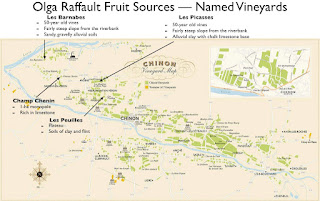The region that is currently called Chinon AOC has been producing grapes and wines for hundreds of years and was rewarded with an AOC designation in 1937. The Olga Raffault family has been making quality wines in this region for over five generations but I was only recently introduced to their offerings. I explore the region, the estate, and its wines in this post.
Chinon AOC
The Chinon AOC covers 18 communes on both sides of the Vienne River prior to its merger with the Loire. There are approximately 1,821 ha of Cabernet Franc vines in the region and, in general, the wines from the area are fresh and supple with flavors and aromas of red fruits and violets. Three different terroirs have been identified and the wine styles vary based on their terroir of origin. The slopes and hills along the Vienne River are composed of a Late-Cretaceous limestone called Tuffeau and the wines from this soil have great structure and aging capability. The area around the commune of Veron is characterized by a Late-Cretaceous clay and produces wines that are intermediate to the lighter Chinons produced in the alluvial sand and gravel soils that can be found in communes such as Panzoult. Chinon wines are barrel-aged but the neutral barrels impart no oak flavors to the wine thus allowing the natural character of the grape to advance unimpeded to the bottle.
Olga Raffault
Olga Raffault is located in Veron commune of Chinon but farms 24 ha across the region: 23 ha of Cabernet Franc and 1 ha of Chenin Blanc. Estate vines average 30 years of age and are distributed over the three Chinon terroirs. The location of the owned vineyards are illustrated in the chart below while the wines, and their construction, follow immediately after.
 |
| Sources and composition of Olga Raffualt wines |
I recently tasted three of the Raffault wines: the 2018 Chinon Blanc Champs-Chenin; the 2018 Olga Raffault Chinon Les Peuilles; and the 2016 Olga Raffault Chinon Les Picasses.
The Chinon Blanc Champs-Chenin showed intense white fruit on the nose along with sage, herbs, and spice. Complex and layered. Brisk acidity on the palate. Citrus and citrus rind accompanying a rust-like minerality. Drying on the palate. Lengthy finish.
Rich, red fruit on the nose for the 2018 Les Peuilles, along with forest floor, gunflint, and a smokiness. Ripe red fruit on the palate. Concentrated. Full round mouthfeel. Late arriving tannins and salinity. Lengthy, coating finish.
The 2016 Les Picasses had a perfumed nose with bright red fruit, spice, minerality, licorice, saltwater taffy and wet cigarette. On the palate, a red fruit core and smooth tannins. Complex and balanced. Long, lean finish.
These three wines were of exceptional quality with the reds approachable but with the peaks 5 to 10 years out. The QPR here is awesome.





No comments:
Post a Comment